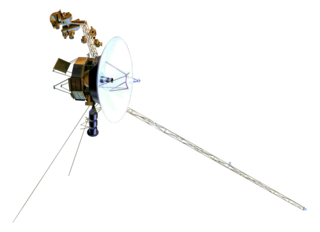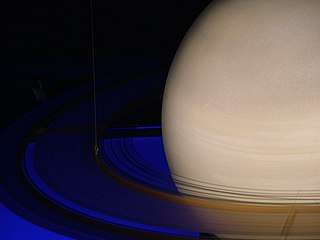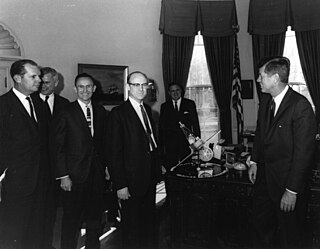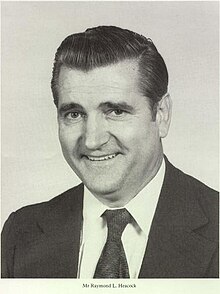
Jet Propulsion Laboratory (JPL) is a federally funded research and development center in the City of Pasadena, California, United States. Founded in 1936 by Caltech researchers, the laboratory is now owned and sponsored by the National Aeronautics and Space Administration and administrated and managed by the California Institute of Technology.

Voyager 1 is a space probe launched by NASA on September 5, 1977, as part of the Voyager program to study the outer Solar System and interstellar space beyond the Sun's heliosphere. Launched 16 days after its twin Voyager 2, Voyager 1 has been operating for 45 years, 10 months and 14 days as of July 20, 2023 UTC [refresh]. It communicates through NASA's Deep Space Network to receive routine commands and to transmit data to Earth. Real-time distance and velocity data is provided by NASA and JPL. At a distance of 159.756 AU from Earth as of July 9, 2023, it is the most distant human-made object from Earth.

Voyager 2 is a space probe launched by NASA on August 20, 1977, to study the outer planets and interstellar space beyond the Sun's heliosphere. As a part of the Voyager program, it was launched 16 days before its twin, Voyager 1, on a trajectory that took longer to reach gas giants Jupiter and Saturn but enabled further encounters with ice giants Uranus and Neptune. Voyager 2 remains the only spacecraft to have visited either of the ice giant planets. Voyager 2 was the third of five spacecraft to achieve Solar escape velocity, which allowed it to leave the Solar System.

The Voyager program is an American scientific program that employs two robotic interstellar probes, Voyager 1 and Voyager 2. They were launched in 1977 to take advantage of a favorable alignment of the two gas giants Jupiter and Saturn and the ice giants, Uranus and Neptune, to fly near them while collecting data for transmission back to Earth. After launch the decision was made to send Voyager 2 near Uranus and Neptune to collect data for transmission back to Earth.

A gravity assist, gravity assist maneuver, swing-by, or generally a gravitational slingshot in orbital mechanics, is a type of spaceflight flyby which makes use of the relative movement and gravity of a planet or other astronomical object to alter the path and speed of a spacecraft, typically to save propellant and reduce expense.

Project Prometheus was established in 2003 by NASA to develop nuclear-powered systems for long-duration space missions. This was NASA's first serious foray into nuclear spacecraft propulsion since the cancellation of the SNTP project in 1995. The project was planned to design, develop, and fly multiple deep space missions to the outer planets.

The Grand Tour is a NASA program that would have sent two groups of robotic probes to all the planets of the outer Solar System. It called for four spacecraft, two of which would visit Jupiter, Saturn, and Pluto, while the other two would visit Jupiter, Uranus, and Neptune. The enormous cost of the project, around $1 billion, led to its cancellation and replacement with Mariner Jupiter-Saturn, which became the Voyager program.
Gary Arnold Flandro is an American aerospace engineer who is currently the professor for the Boling Chair of Excellence in Space Propulsion (Emeritus) at the University of Tennessee Space Institute. He is also the Vice President and Chief Engineer for Gloyer-Taylor Laboratories (GTL).
Gary L. Bennett is an American scientist and engineer, specializing in aerospace and energy. He has worked for NASA and the US Department of Energy (DOE) on advanced space power systems and advanced space propulsion systems. His professional career has included work on the Voyager, Galileo, and Ulysses space missions, and is currently working as a consultant in aerospace power and propulsion systems. He is also a science fiction author.

The exploration of Uranus has, to date, been through telescopes and a lone probe by NASA's Voyager 2 spacecraft, which made its closest approach to Uranus on January 24, 1986. Voyager 2 discovered 10 moons, studied the planet's cold atmosphere, and examined its ring system, discovering two new rings. It also imaged Uranus' five large moons, revealing that their surfaces are covered with impact craters and canyons.

The exploration of Saturn has been solely performed by crewless probes. Three missions were flybys, which formed an extended foundation of knowledge about the system. The Cassini–Huygens spacecraft, launched in 1997, was in orbit from 2004 to 2017.

Neptune has been directly explored by one space probe, Voyager 2, in 1989. As of December 2022, there are no confirmed future missions to visit the Neptunian system, although a tentative Chinese mission has been planned for launch in 2024. NASA, ESA, and independent academic groups have proposed future scientific missions to visit Neptune. Some mission plans are still active, while others have been abandoned or put on hold.

Edward Carroll Stone is an American space scientist, professor of physics at the California Institute of Technology, and former director of the NASA Jet Propulsion Laboratory (JPL).

Robert J. "Bob" Parks was a US aerospace engineer and pioneer in the space program where he was intricately involved and/or directed for some of the most historic and important U.S. unmanned space missions. Over a 40-year tenure at the Jet Propulsion Laboratory (JPL/NASA), located in Pasadena, California, Parks’ impact was essential to helping the United States lead the world in space exploration. He served as Guidance Engineer for Explorer 1, the first successfully launched satellite by the United States. He directed the initial flyby missions to the Moon, the first soft landing on the Moon, Earth's first successful mission to another planet and initial missions to Mars, Saturn, Jupiter and Uranus.
Robert Samuel Kraemer was an American aerospace engineer who served as Director of Planetary Programs at the National Aeronautics and Space Administration from 1971 to 1976.
Candice Joy Hansen-Koharcheck is a planetary scientist. She is responsible for the development and operation of the JunoCam, for which she received the NASA's Outstanding Public Leadership Medal in 2018.

John R. Casani is an American engineer. He worked for the National Aeronautics and Space Administration (NASA) at the Jet Propulsion Laboratory, where he managed the Voyager, Galileo, Cassini and Prometheus projects.

Galileo was an American robotic space probe that studied the planet Jupiter and its moons, as well as the asteroids Gaspra and Ida. Named after the Italian astronomer Galileo Galilei, it consisted of an orbiter and an entry probe. It was delivered into Earth orbit on October 18, 1989, by Space ShuttleAtlantis , during STS-34. Galileo arrived at Jupiter on December 7, 1995, after gravitational assist flybys of Venus and Earth, and became the first spacecraft to orbit an outer planet.













